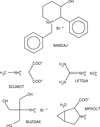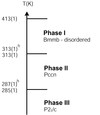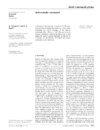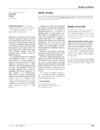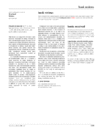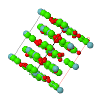issue contents
August 2003 issue

Cover illustration: Orange polytypically disordered crystals of HgI2 are built from layers of corner-linked Hg4I10 supertetrahedra. The stacking disorder has been quantitatively analyzed with a Markov chain model. Two probabilities describing next-nearest-layer interactions were adjusted to observed diffuse intensity profiles extracted from image-plate detector data. Results show nearly equal volumes of the two maximum degree of order structures, with an average domain thickness of about 5 layers or 30 Å [Hostettler, Birkedal & Schwarzenbach (2002), Acta Cryst. B58, 903-913].
research papers
Download citation


Download citation


Crystal structures of coexisting polytypes of YV4O8 were analyzed based on a commensurate composite crystal model, and domain structure was examined through diffuse streak simulation by the matrix method for one-directional disorder.
Expressions are developed for the force constants and compressibilities of chemical bonds.
The refinement of the structure of Nd5Ti5O17 from a restored high-resolution exit-plane wave is reported.
A detailed structural mechanism which is based on crystallographic shear is proposed for the morphotropic transformation between the rutile and corundum structural types. The influence of randomly spaced and clustered CS planes on the X-ray diffraction patterns is calculated.
A rock-salt pattern of cation ordering in the ordered double perovskites A2BB′X6, combined with simple tilting of the octahedral units, leads to a number of distinct but closely related structures. There are 12 possible space groups listed, along with group–subgroup relationships and an indication of which transitions between the different structures are allowed to be continuous.
Download citation


Download citation


The crystal structures of the rare-earth members of the series RMo5O8 (R = La to Gd) have been refined from single-crystal X-ray diffraction data. The evolution of the Mo—Mo distances with respect to the size and the charge of the cation as well as theoretical investigations are presented.
Download citation


Download citation


The crystal structure of [Fe(PM-BiA)2(NCS)2] form II is discussed, and compared with form I. Direct correlation between the structural and magnetic spin cross-over feature are drawn.
Download citation


Download citation


Crystals of the title compound and its hydrate are centrosymmetric. In the hydrate, homodromic arrays of hydrogen-bonded water molecules form a locally noncentrosymmetric structure. The disorder of these arrays over the two possible orientations creates an overall centrosymmetric structure.
Download citation


Download citation


Structure and packing of (1E)-N′-[(E)-2-cyano-1-(dimethylamino)-2-nitrovinyl]-N,N-dimethylethanimidamide in two polimorphic phases are discussed.
A group contribution method to estimate crystal densities is extended to molecular salts, with applications in energetic materials.
Download citation


Download citation


Two polymorphs of a TTF-based charge-transfer complex using 9-dicyanomethylene-4,5,7-trinitrofluorene-2-carboxylic acid methyl ester as an acceptor were synthesized and their crystal structures determined, revealing differences in crystal packing. The observed structural features are in agreement with IR data and correlate well with the calculated degree of charge transfer for each polymorph.
Linear and directional Y—X⋯B halogen bonds are found; their distances depend on the Lewis acidity of YX and the Lewis basicity of B.
Download citation


Download citation


The structures of the 1:1 adduct of hexamethylenetetramine and pimelic acid are investigated. A model based on a stacking sequence of an elementary layer is proposed for describing the different structures in a unified scheme. The main features observed on diffraction patterns are reproduced by simulation using the model.
short communications
book reviews
Free 

books received
Free 



 journal menu
journal menu




















